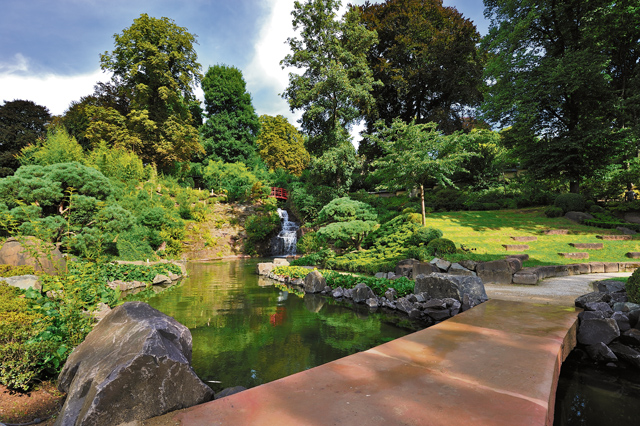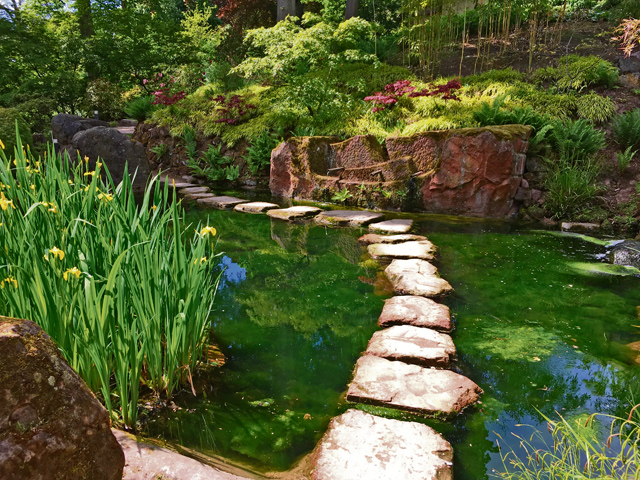
A staple of Kaiserslautern for nearly 25 years, the Japanese Garden (Japanischer Garten) is one of the city’s best-kept secrets. Though a quiet natural oasis, the Japanese Garden is anything but boring. Filled with gorgeous flora, clear ponds, lovely waterfalls, and maze-like paths, it allows visitors to find peace or adventure.
Where TikTok meets tranquility
It is a weekday afternoon in late spring. Storm clouds gather to the west, and sun filters in through the leaves of a massive beech tree. The sound of rushing water comes from somewhere beyond a curved ridge. I have just finished picking my way over a railing-less wooden bridge where koi dart in the pond water below. German voices come from behind a Japanese maple. I round a corner. And boom: in one of the most tranquil places in Germany, two dyed-hair teenage TikTok skateboard stars are setting up a camera. Kaiserslautern’s Japanese Garden is about to become Internet-famous, at least for one fleeting moment. The beautiful thing? No one seems to mind. After all, a Japanese garden encourages contemplation of a deeper sense of time: all things pass, even TikTok.
Kaiserslautern’s Japanese Garden: A brief history
The largest of its kind in Germany, Kaiserslautern’s Japanese Garden was founded in 2000, three years after a local association (called “Friends of the Japanese Garden”) began working to assure its existence.
Since then, the garden has continued to expand and thrive. A new gate was opened in 2006, to accompany the arrival of the Japanese national soccer team in Kaiserslautern (where they gave up three heartbreaking goals in the last 10 minutes of their match against Australia to lose 3-1). During the past three years, both the iconic red entrance gate and the red pedestrian bridge have been renovated. The result of nearly a quarter-century of work? An amazing place to visit – for people of all ages.

A welcoming place
The whole goal of Japanese gardens is to allow visitors to understand that humans are part of nature. Kaiserslautern’s garden does this in a number of ways.
First of all, the space itself is barrier-free. The paths aren’t straight, and are all connected. Which means visitors get to choose their own adventure. You can navigate huge stepping stones and walk straight through the large red gate just beyond the entrance. You can also amble leftward toward the base of two large ponds where shiny golden koi swim beneath the surface.
Secondly, the garden is perfect – and open for – any number of events or non-events. Benches are everywhere, so visitors can sit, listen, reflect, or chat. Cosplay events are a staple of the garden, and have been hosted there for nearly a decade. The afternoon I visited, six book clubbers were having a champagne picnic. There were, of course, the aforementioned skateboard-wielding teenagers doing their best to blow minds by doing rad tricks inside a Japanese garden. Mostly, there were visitors like me who were turned briefly into searchers and wanderers.
Finally, Kaiserslautern’s Japanese Garden poses options and challenges for visitors of all ages. Kids will love it. There are many maze-like patterns, and a surprisingly rugged terrain: the garden is located more or less on a hillside with a 60-foot elevation difference, so some of the walking can be strenuous for those with limited mobility. And those who aren’t quite up for vertical exploring will be pleased, too. There is much to see and do at the bottom of the hill.
Harmony between nature and structure
Even non-tree nerds will appreciate the vegetation in the Japanese garden. Ancient and enormous beeches tower throughout the garden, their presence a nod to Germany’s most famous trees. The garden contains yew, gingko, and Japanese maple trees, as well as bamboo. Flowers and other plants flourish. As the seasons change, the garden evolves beautifully. Spring is filled with pinks, autumn with reds and oranges, winter with unexpected greens.
There are also amazing structures within the garden, including an authentic Japanese tea house that was originally built in Tokyo in 1900 and ended up in Kaiserslautern a century later. Multiple bridges criss-cross the water features, including a curved red bridge that overlooks a 40-foot waterfall, and a stone bridge that allows visitors to tiptoe across a small pond just beyond the red gate.
And, if anyone gets hungry, you can visit the snack bar (the Japanese Imbiss). Or, like many do, you can bring your own snacks.
Kaiserslautern Japanese Garden – essentials
From May to September, the garden is open Tuesday through Sunday from 10 a.m. to 7 p.m. Tickets cost €6.50 for visitors ages 12 and older. Children 11 and under are free. Due to the delicate nature of the landscape, dogs are not allowed.
Though open year-round, hours are limited during the winter. Please visit https://www.japanischergarten.de/besuchen/oeffnungszeiten-preise for specific visiting times.
Located downtown, next to a tall county administration building, the Japanese Garden is very accessible via public transportation. If you’re driving, parking spots are generally available at the nearby Meuthstrasse lot. If you’re in the Fussganger zone, it’s a short (5-10 minute) walk away, as well.


